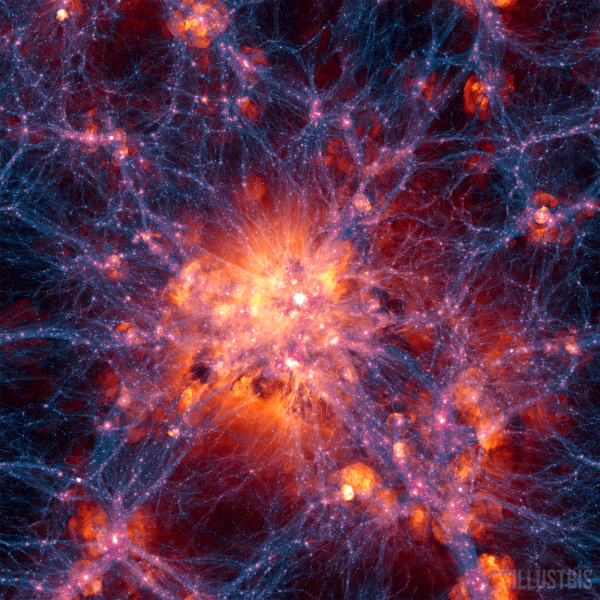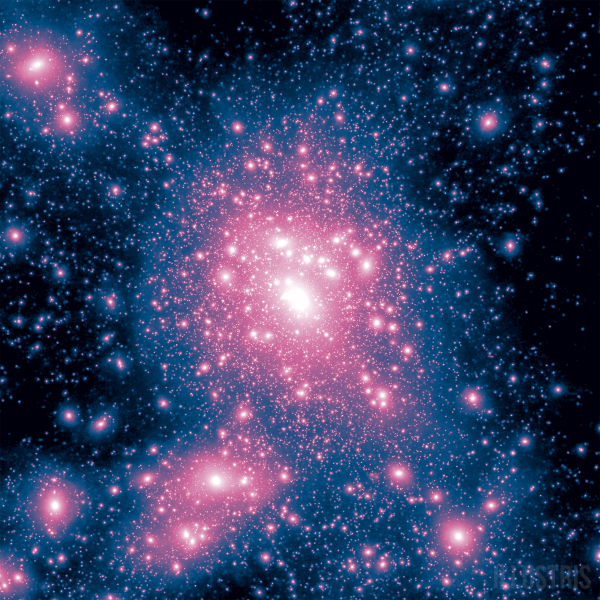Landmark Computer Model Reproduces the Evolution of the Entire Universe
| Robert Sarkanen | | May 08, 2014 09:11 AM EDT |
(Photo : Illustris Collaboration) Large scale projection centered on the most massive cluster in the Illustris volume. Shows dark matter density overlaid with the gas velocity field.
(Photo : Illustris Collaboration) Dark matter annihilation radiation map of the most massive cluster. The group of this cluster only has over 65 million DM particles and 16937 resolved substructures.
Despite huge advances in technology, no single computer model simulation has been able to recreate the complexity of the start and evolution of the universe. Until now.
Astronomers of the Harvard-Smithsonian Center for Astrophysics announced in the journal Nature today the results of a three-month long computer process culminating in a model known as "Illustris". It was completed in late 2013 but the results were being published only now.
Like Us on Facebook
The process involved 8,000 individual CPUs all running in parallel in order to model the known universe. To put these numbers in perspective, if the same simulation was carried out on a single home desktop computer, it would take around 2,000 years to recreate.
With visuals difficult to distinguish from real observations, Illustris can appear reminiscent of the new hit TV-show on Fox, Cosmos: A Spacetime Odyssey, which also charts the history of the universe. But whereas the documentary show is an artistic representation, Illustris is a comprehensive simulation, using theories culled from decades of astronomical observations. Importantly, Illustris is also allowed to evolve with time as new theories arise in the future.
Previous similar work were either too low in resolution or focused only on tiny portions of the cosmos. Illustris is instead based on the entire universe as a 3D model, 350 million light-years across. It simulates the movements and evolution of all planets and stars over the past 13.8 billion years, starting 12 million years after the Big Bang.
The Illustris model shows the first matter pooling together to form the first stars and galaxies and eventually planets. It allows scientists to zoom in on specific areas and allows researchers to focus on different mechanisms of space. Co-author Shy Genel described Illustris as a "time machine", allowing astronomers to go back and forth through time and pause to see what went on, throughout the long history of the universe.
The invisible so-called dark matter and dark energy are also included in the calculations, both of which are believed to make up the majority of all matter in the universe but has yet to be observed directly. The dark matter anchors the clusters of stars and galaxies in what is visualized in the simulation as a "cosmic web" of the invisible stuff.
Given the large-scale nature of the work and the sheer amount of equations interacting in all kinds of ways, some anomalies in the simulation differ notably from observations, raising new questions for astronomers to answer about how the cosmos works.
TagsComputer Simulation, Universe, Astronomy, Illustris, Harvard, Smithsonian, Center for Astrophysics, Astrophysics
©2015 Chinatopix All rights reserved. Do not reproduce without permission
EDITOR'S PICKS
-

Did the Trump administration just announce plans for a trade war with ‘hostile’ China and Russia?
-

US Senate passes Taiwan travel bill slammed by China
-

As Yan Sihong’s family grieves, here are other Chinese students who went missing abroad. Some have never been found
-

Beijing blasts Western critics who ‘smear China’ with the term sharp power
-

China Envoy Seeks to Defuse Tensions With U.S. as a Trade War Brews
-

Singapore's Deputy PM Provides Bitcoin Vote of Confidence Amid China's Blanket Bans
-

China warns investors over risks in overseas virtual currency trading
-

Chinese government most trustworthy: survey
-

Kashima Antlers On Course For Back-To-Back Titles
MOST POPULAR
LATEST NEWS
Zhou Yongkang: China's Former Security Chief Sentenced to Life in Prison

China's former Chief of the Ministry of Public Security, Zhou Yongkang, has been given a life sentence after he was found guilty of abusing his office, bribery and deliberately ... Full Article
TRENDING STORY

China Pork Prices Expected to Stabilize As The Supplies Recover

Elephone P9000 Smartphone is now on Sale on Amazon India

There's a Big Chance Cliffhangers Won't Still Be Resolved When Grey's Anatomy Season 13 Returns

Supreme Court Ruled on Samsung vs Apple Dispute for Patent Infringement

Microsoft Surface Pro 5 Rumors and Release Date: What is the Latest?











